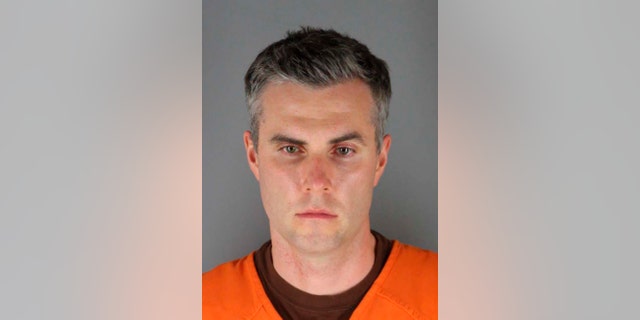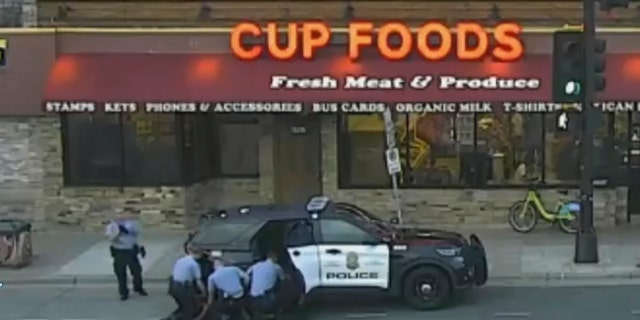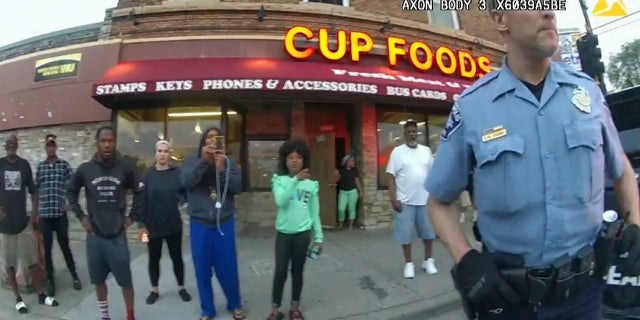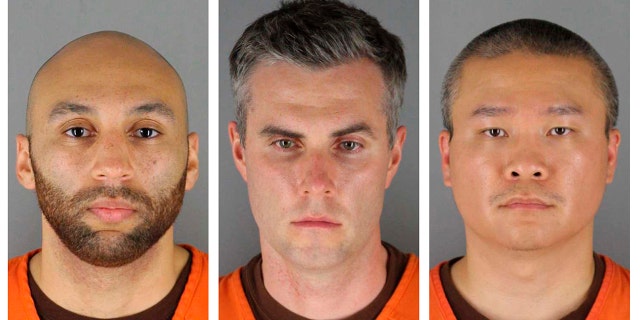NEWYou can now listen to Fox News articles!
ST. PAUL, Minn. — A former Minneapolis police officer charged with violating George Floyd‘s civil rights testified Monday that he thought Floyd was doing OK while handcuffed, facedown on the street with Officer Derek Chauvin’s knee pressed to his neck — until paramedics arrived and turned Floyd over.
Thomas Lane, 38, said during his federal trial that that was the first time he had seen Floyd’s face since police had put the 46-year-old Black man on the ground while struggling to arrest him. Before that, as he held Floyd’s legs, he thought he saw Floyd’s chest rise and fall, Lane testified, and believed Floyd still had blood pressure based on the appearance of veins in his arm.
“What went through your mind when you saw his face there, once he was tipped over?” Lane’s attorney, Earl Gray, asked.
OFFICER SAYS HE DIDN’T REALIZE GEORGE FLOYD’S LIFE WAS IN DANGER
Former Police Officer Thomas Lane appears before U.S. District Judge Magnuson during his trial in the killing of George Floyd in federal court in St. Paul, Minn., on Monday, Feb. 21, 2022.
(Cedric Hohnstadt via AP)
“Um. He didn’t look good,” Lane said while testifying at the trial for himself, Tou Thao and J. Alexander Kueng.
All three former officers are all charged with depriving Floyd of his right to medical care. Kueng and Thao are also charged with failing to intervene to stop Chauvin in the May 25, 2020, killing that triggered protests worldwide and a re-examination of racism and policing. Kueng knelt on Floyd’s back and Thao kept bystanders back.
On cross-examination, Lane told prosecutor Samantha Trepel that he was trained that he had a duty to intervene and to provide medical care if needed. Lane said when someone doesn’t have a pulse, CPR should be started as soon as possible “in ideal situations,” but said that isn’t always possible in law enforcement.

This photo provided by the Hennepin County Sheriff’s Office in Minnesota on Wednesday, June 3, 2020, shows Thomas Lane.
(Hennepin County Sheriff’s Office via AP File)
Earlier, Lane testified that Floyd struggled with officers as they tried to put Floyd into a squad car while responding to a complaint that he had used a counterfeit $20 bill at a corner store. Lane said he called an ambulance because Floyd was bleeding.
Once officers had Floyd on the ground, Lane said, they considered using a hobble — a restraint device that would have required that Floyd be put on his side so that he could breathe more easily. The hobble has straps that bind the ankles together, and can also attach to someone’s waist.
Lane said Thao got the device, but then it was suggested that they not use it. Lane said Thao noted that if they used the device, they would have to call a supervisor to the scene. Also, the device would have to be removed for paramedics.
“It seemed kind of excessive because we had an ambulance coming,” Lane said.

FILE – In this image from surveillance video, Minneapolis police Officers from left, Tou Thao, Derek Chauvin, J. Alexander Kueng and Thomas Lane are seen attempting to take George Floyd into custody in Minneapolis, Minn on May 25, 2020.
(Court TV via AP, Pool, File)
Lane said he also suggested putting Floyd’s legs up, since he was kicking, but that “Officer Chauvin said, ‘No, we’re good.'”
Lane said Floyd stopped resisting after about four minutes on the ground. He recalled asking if they should roll Floyd onto his side, and Chauvin said no. Lane said he was worried about “excited delirium,” a disputed condition that he said he understood to be kind of an “adrenaline overdose.”
Lane also said that at one point, he heard a bystander say Floyd wasn’t breathing, but Lane responded that he was. Asked why he said that, Lane testified, “I could see his chest rise and fall.”
MINNEAPOLIS TRIAL: TEEN BYSTANDER COULD INSTANTLY TELL GEORGE FLOYD WAS ‘IN DISTRESS,’ SHE TESTIFIES
He said even after he couldn’t find a pulse in Floyd’s ankle, he thought Floyd still had blood pressure because he could see that the veins in Floyd’s arm were raised.

In this image from police body camera video shown as evidence in court, paramedics arrive as Minneapolis police officers, including Derick Chauvin, second from left, and J. Alexander Kueng restrain George Floyd in Minneapolis, on May 25, 2020.
(Minneapolis Police Department via AP, File)
When the ambulance arrived, a paramedic checked for a pulse in Floyd’s neck. Since the paramedic did not act with urgency, Lane said he still believed Floyd was OK.
But once Lane saw Floyd’s face, he got into the ambulance to help and was told to do chest compressions, he said.
As he recalled efforts to save Floyd’s life, he paused a few times and sniffed.
“I wasn’t sure if he was breathing or not,” Lane said.

FILE – In this image from police body camera video former Minneapolis police Officer Derek Chauvin stands outside Cup Foods in Minneapolis, on May 25, 2020, with a crowd of onlookers behind him.
(Court TV via AP, Pool, File)
Prosecutors have argued that the officers violated their training by not rolling Floyd onto his side or giving him CPR. Defense attorneys have attacked the department’s training as inadequate and have highlighted a culture that they said emphasized deference to senior officers like Chauvin.
Lane agreed with Trepel that he was trained to move someone from a prone position if possible. He also acknowledged that in statement to state investigators about six days after the killing, he said he felt like the situation “could have been handled differently.”
Kueng and Thao testified last week. Thao said he was relying on the other three officers to care for Floyd’s medical needs while he controlled the crowd and traffic. Kueng, who like Lane was a rookie, said he deferred to Chauvin.

FILE – This combination of photos provided by the Hennepin County Sheriff’s Office in Minnesota on June 3, 2020, shows, from left, former Minneapolis police officers J. Alexander Kueng, Thomas Lane and Tou Thao.
(Hennepin County Sheriff’s Office via AP, File)
Lane, who followed in the steps of his father, grandfather and great-grandfather when he became a Minneapolis police officer, testified that cadets were told to call officers “Sir or “Ma’am,” and stand at attention when they came in the room.
Lane, who is White; Kueng, who is Black; and Thao, who is Hmong American, also face a separate state trial in June on charges alleging that they aided and abetted murder and manslaughter.
CLICK HERE TO GET THE FOX NEWS APP
Chauvin, who is White, was convicted in state court of murder and pleaded guilty in December to a federal civil rights charge.